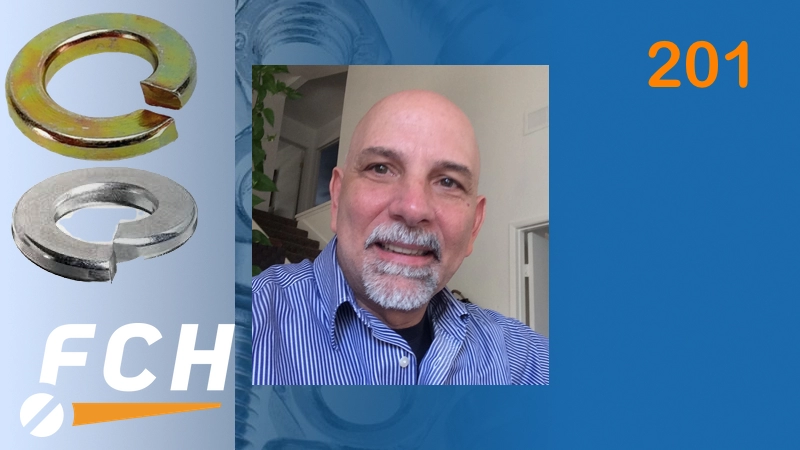This edition of the Fastener Training Minute with Carmen Vertullo was originally published June 22nd, 2024 as “What coatings can you safely put on lock washers” during episode 201 of Fully Threaded Radio.
Well hello everyone, this is Carmen Vertullo with your Fastener Training Minute, coming to you from Fastener Training Institute and Carver Labs in beautiful El Cajon California.
Today’s topic is about lock washers and specifically the coatings or finishes that we put on lock washers, and some of the things that can get us into trouble when we don’t adequately specify lock washer coatings, so when I come back I will tune you up on lock washer coatings.
Welcome back everybody. We’re talking about lock washer coatings today. And when I say lock washers, I’m specifically talking about split lock washers, and tooth lock washers, I would even go so far as to say even though it’s not a lock washer technically, conical hardened washers. And basically when we say split lock and tooth lock and conical washers, we’re talking about hard steel washers. And as you know, when we deal with any fastener that has a load on it, that has a hardened steel material, we need to be concerned about hydrogen embrittlement whenever we put them into an application that could be detrimental in that regard. So we typically think lock washers are under compression or all washers are under compression and typically they are. So flat washers are not so much an issue as lock washers are, and the reason is because lock washers actually do see a change in their shape. They go under stress and strain and minor amounts of bending compared to the amount of bending that a bolt goes through. Or I should say the stress and strain that a bolt goes through it is relatively significant because a split lock washer, for example, goes from a coil to flat. So that metal moves around a lot and it’s under stress. For that reason, and we’re going to mainly about inch standards here, but it also applies to ISO metric standards.
ASME b18.21 is where these lock washer standards are referenced, and they specifically warn us against electroplating hardened helical spring lock washers and tooth lock washers, because they both will offer some amount of distortion on installation. Now it’s very common to see both of these types of washers electroplated. It’s better to use some non electroplated finish which is very common for split lock washers, which would be mechanical zinc. Also for conical washers we see mechanical zinc, but not so much for the tooth lock washers. We still do see those primarily electroplated zinc. They’re nice shiny silver or Shiny Gold if it’s yellow zinc, which by the way those very nice looking spangly tooth loss washers make great earrings, and they also make great Christmas tree ornaments in the larger size ask me how I know. I’ve worn those earrings, and of hung those Christmas tree ornaments they work out great but you have to be careful that you don’t end up with hydrogen embrittlement if you choose to electroplate them. And the standard ASME b18.21 standard is very clear. It warns us against this, it says specifically electroplating carbon and boron steel lock washers, and I would say any steel, is not recommended because of the possibility of hydrogen embrittlement failures.
When the purchaser specifies electroplated lock washers, they must be baked after plating, using times and temperature suitable for relieving potential trapped hydrogen. It goes on to say all lots of electroplated lock washers shall be tested by compressing them to the flat condition for a minimum of forty-eight hours, within which time they must not fracture. Compression shall be accomplished between parallel flat surfaces. That is about the simplest, most effective hydrogen embrittlement test you will ever see. It’s very easy to do you just stack them on a bolt eight or ten at a time and you come down with a nut until they’re flat. We also see often times we may run into corrosion and issues with the coating that we choose for these washers, especially if we choose mechanical zinc which in its thinnest form we would use ASME b695 for that coating. And that coating comes in lots of thicknesses, and it can be very thin in some cases, and we should be using class 55, which adds adequate corrosion resistance if we also include a top coat. But be very careful, because especially with our conical washers, they may come from overseas already coated with with the ASME b695 mechanical zinc, but no top coat. It’s better to use possibly a dip spin coating on those and oftentimes they’re actually even painted, because they took them to match whatever they’re going to be assembled with.
So there are other things to say but I think you get the gist of it. You need to be careful when electroplating high hardness metal or fasteners of any type. But be aware it also applies to lock washers even though they’re in compression. I would extend this to hardened flat washers such as ASTM F436 washers, even though those are not subject to bending. However if you happen to put them on a larger hole or you put them across the slot they can experience the kind of bending that could cause hydrogen embrittlement failures to occur. And I’ve seen it happen, that’s why I’m telling you about it.
Well that’s about all there is to say and possibly all there is to know about the cautions you need to follow when putting coatings on hardened steel lock washers and flat washers.
This has been Carmen Vertullo with the Fastener Training Minute, thanks for listening.




![[GC2610] Solution_FCH Banner_[220x100] copy](https://news.fastenersclearinghouse.com/wp-content/uploads/2025/09/banner_solutionind.jpg)

